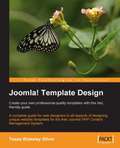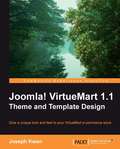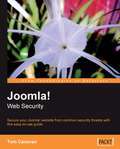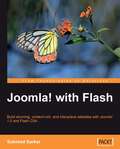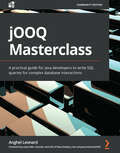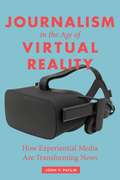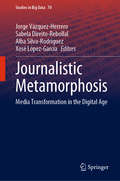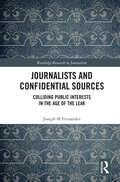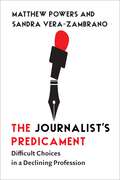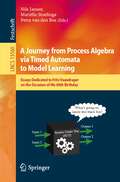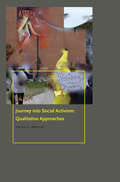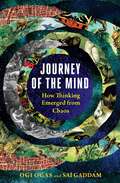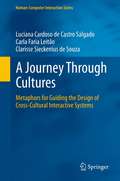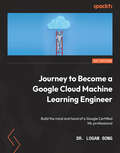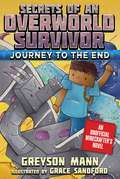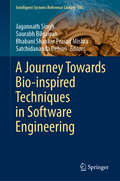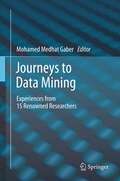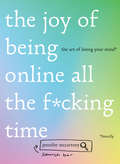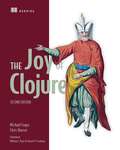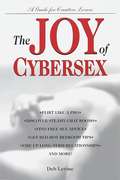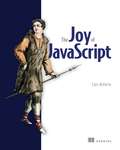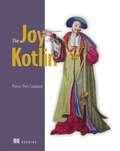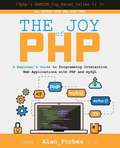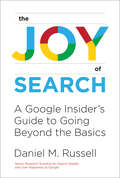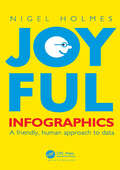- Table View
- List View
Joomla! Template Design: Create your own professional-quality templates with this fast, friendly guide
by Tessa Blakeley SilverThis book is aimed at web designers who want to create their own unique templates for Joomla!. Readers should have basic knowledge of Joomla! (which can be obtained by working through Building Websites with Joomla!) and also some knowledge of CSS and HTML, and using Dreamweaver for coding purposes.
Joomla! VirtueMart 1.1 Theme and Template Design
by Joseph KwanThis book is a step-by-step tutorial that will teach you to customize VirtueMart templates and themes. It includes all the essential screenshots and code with exhaustive explanations accompanied by exercises to ensure good pickup.You may be the owner of a Joomla! VirtueMart web store or a designer working with Joomla! VirtueMart. If you want to customize VirtueMart to unleash its enormous potential and elevate your store to the next level, this book is for you. You must have some experience with VirtueMart and understand its basic features. You also need to know HTML and should be comfortable taking up some challenges in PHP and JavaScript programming.
Joomla! Web Security
by Tom CanavanThis book will give you a strong, hands-on approach to security. It starts out with the most basic of considerations such as choosing the right hosting sites then moves quickly into securing the Joomla! site and servers. This is a security handbook for Joomla! sites. It is an easy-to-use guide that will take you step by step into the world of secured websites. This book is a must-read for anyone seriously using Joomla! for any kind of business, ranging from small retailers to larger businesses. With this book they will be able to secure their sites, understand the attackers, and more, without the drudging task of looking up in forums, only to be flamed, or not even find the answers. Prior knowledge of Joomla! is expected but no prior knowledge of securing websites is needed for this book. The reader will gain a moderate to strong level of knowledge on strengthening their sites against hackers.
Joomla! with Flash
by Suhreed SarkarThis book is a fast-paced step-by step-guide. It is loaded with examples and lots of illustrations showing configurations and their results on the screen. If you are a Joomla! web developer who wants to integrate Flash into your web sites, then this book is for you. Knowledge of Joomla! and basic knowledge of Flash is assumed.
jOOQ Masterclass: A practical guide for Java developers to write SQL queries for complex database interactions
by Anghel Leonard Lukas EderLearn the best way to write SQL in Java by taking control of SQL in your app via a type-safe, dynamic and versatile API that supports almost any type or feature compatible with a database and emphasizes SQL syntax correctnessKey FeaturesWrite complex, type-safe, and dynamic SQL using the powerful jOOQ APITackle complex persistence tasks, such as lazy fetching, R2DBC, transactions, and batching while sustaining high traffic in your modern Java applicationsUse a comprehensive SPI to shape and extend jOOQ according to your needsBook DescriptionjOOQ is an excellent query builder framework that allows you to emulate database-specific SQL statements using a fluent, intuitive, and flexible DSL API. jOOQ is fully capable of handling the most complex SQL in more than 30 different database dialects.jOOQ Masterclass covers jOOQ from beginner to expert level using examples (for MySQL, PostgreSQL, SQL Server, and Oracle) that show you how jOOQ is a mature and complete solution for implementing the persistence layer. You'll learn how to use jOOQ in Spring Boot apps as a replacement for SpringTemplate and Spring Data JPA. Next, you'll unleash jOOQ type-safe queries and CRUD operations via jOOQ's records, converters, bindings, types, mappers, multi-tenancy, logging, and testing. Later, the book shows you how to use jOOQ to exploit powerful SQL features such as UDTs, embeddable types, embedded keys, and more. As you progress, you'll cover trending topics such as identifiers, batching, lazy loading, pagination, and HTTP long conversations. For implementation purposes, the jOOQ examples explained in this book are written in the Spring Boot context for Maven/Gradle against MySQL, Postgres, SQL Server, and Oracle.By the end of this book, you'll be a jOOQ power user capable of integrating jOOQ in the most modern and sophisticated apps including enterprise apps, microservices, and so on.What you will learnEnable the jOOQ Code Generator in any combination of Java and Kotlin, Maven and GradleGenerate jOOQ artifacts directly from database schema, or without touching the real databaseUse jOOQ DSL to write and execute a wide range of queries for different databasesUnderstand jOOQ type-safe queries, CRUD operations, converters, bindings, and mappersImplement advanced SQL concepts such as stored procedures, derived tables, CTEs, window functions, and database viewsImplement jOOQ multi-tenancy, tuning, jOOQ SPI, logging, and testingWho this book is forThis book is for Java developers who write applications that interact with databases via SQL. No prior experience with jOOQ is assumed.
Journalism in the Age of Virtual Reality: How Experiential Media Are Transforming News
by John PavlikWith the advent of the internet and handheld or wearable media systems that plunge the user into 360º video, augmented—or virtual reality—technology is changing how stories are told and created. In this book, John V. Pavlik argues that a new form of mediated communication has emerged: experiential news. Experiential media delivers not just news stories but also news experiences, in which the consumer engages news as a participant or virtual eyewitness in immersive, multisensory, and interactive narratives.Pavlik describes and analyzes new tools and approaches that allow journalists to tell stories that go beyond text and image. He delves into developing forms such as virtual reality, haptic technologies, interactive documentaries, and drone media, presenting the principles of how to design and frame a story using these techniques. Pavlik warns that although experiential news can heighten user engagement and increase understanding, it may also fuel the transformation of fake news into artificial realities, and he discusses the standards of ethics and accuracy needed to build public trust in journalism in the age of virtual reality. Journalism in the Age of Virtual Reality offers important lessons for practitioners seeking to produce quality experiential news and those interested in the ethical considerations that experiential media raise for journalism and the public.
Journalistic Metamorphosis: Media Transformation in the Digital Age (Studies in Big Data #70)
by Jorge Vázquez-Herrero Sabela Direito-Rebollal Alba Silva-Rodríguez Xosé López-GarcíaThis book aims to reflect how journalism has changed in recent years through different perspectives concerning the impact of technology, the reconfiguration of the media ecosystem, the transformation of business models, production and profession, as well as the influence of digital storytelling, mobile devices and participation within the context of glocal information.Journalism innovation implies modifications in techniques, technologies, processes, languages, formats and devices intended to enhance the production and consumption of the journalistic information.This book becomes an interesting resource for researchers and professionals working in news media to identify the best practices and discover new types of information flows in a rapidly changing news media landscape.
Journalists and Confidential Sources: Colliding Public Interests in the Age of the Leak (Routledge Research in Journalism)
by Joseph M FernandezJournalists and Confidential Sources explores the fraught and widespread reliance by journalists on anonymous sources, whistleblowers and others to whom they owe an obligation of confidentiality. It examines the difficulties afflicting such relationships; the deteriorating ‘right to know’ and freedom of expression frameworks; and explores solutions and reforms. The book discusses key Australian and international source protection ethics rules, statutes, court cases, law enforcement actions and case studies. It highlights weakness in journalists’ professional practice codes governing confidentiality obligations; discusses inadequate journalistic appreciation of the importance of establishing clear terms and conditions underpinning confidentiality obligations; and identifies shortcomings in the law governing source protection. The book argues that despite source protection being widely recognised as an important ideal, source protection is under sustained assault, thereby undermining public access to information, and democracy itself. The work focusses on Australia, but takes into account source protection in the United Kingdom, the United States, Canada and New Zealand. This timely contribution to the global discussion on the subject will greatly interest journalists, scholars, educators, and students especially in the areas of media law and policy, journalism, media and communication studies, and public relations; the legal fraternity; and anyone who communicates with journalists.
The Journalist's Predicament: Difficult Choices in a Declining Profession
by Matthew Powers Sandra Vera-ZambranoLow pay. Uncertain work prospects. Diminished prestige. Why would anyone still want be a journalist? Drawing on in-depth interviews in France and the United States, Matthew Powers and Sandra Vera-Zambrano explore the ways individuals come to believe that journalism is a worthy pursuit—and how that conviction is managed and sometimes dissolves amid the profession’s ongoing upheavals.For many people, journalism represents a job that is interesting and substantial, with opportunities for expression, a sense of self-fulfillment, and a connection to broader social values. By distilling complex ideas, holding the powerful to account, and revealing hidden realities, journalists play a crucial role in helping audiences make sense of the world. Experiences in the profession, though, are often far more disappointing. Many find themselves doing tasks that bear little relation to what attracted them initially or are frustrated by institutions privileging what sells over what informs. The imbalance between the profession’s economic woes and its social importance threatens to erode individuals’ beliefs that journalism remains a worthwhile pursuit. Powers and Vera-Zambrano emphasize that, as with many seemingly individual choices, social factors—class, gender, education, and race—shape how journalists make sense of their profession and whether or not they remain in it.An in-depth story of one profession under pressure, The Journalist’s Predicament uncovers tensions that also confront other socially important jobs like teaching, nursing, and caretaking.
A Journey from Process Algebra via Timed Automata to Model Learning: Essays Dedicated to Frits Vaandrager on the Occasion of His 60th Birthday (Lecture Notes in Computer Science #13560)
by Nils Jansen Mariëlle Stoelinga Petra van den BosThis Festschrift, dedicated to Frits W. Vaandrager on the occasion of his 60th birthday, contains papers written by many of his closest collaborators. Frits has been a Professor of Informatics for Technical Applications at Radboud University Nijmegen since 1995, where his research focuses on formal methods, concurrency theory, verification, model checking, and automata learning. The volume contains contributions of colleagues, Ph.D. students, and researchers with whom Frits has collaborated and inspired, reflecting a wide spectrum of scientific interests, and demonstrating successful work at the highest levels of both theory and practice.
Journey into Social Activism: Qualitative Approaches
by Joshua D. AtkinsonAcademic study of social activism and social movements has become increasingly prevalent over the years; this is due in large part to the fact that activists have captured public imagination and gained substantial influence in political discourse. For instance, Occupy Wall Street activists, Tea Party activists, and activists affiliated with the Arab Spring have transformed political debates and have become the focus of mainstream news media coverage about a variety of different political topics. Journey into Social Activism explicates the philosophical foundations of the study of activism and illustrates four different research sites in which activism can be observed and studied: organizations, networks, events, and alternative media. The book will introduce students and scholars to important qualitative approaches to the study of social activism within these four research sites, which is based entirely on successful research projects that have been conducted and published in recent years. Ultimately, this book will prove integral to any students and scholars who wish to use qualitative methods for their research endeavors concerning social activism in contemporary society.
Journey of the Mind: How Thinking Emerged from Chaos
by Sai Gaddam Ogi OgasTwo neuroscientists reveal why consciousness exists and how it works by examining eighteen increasingly intelligent minds, from microbes to humankind—and beyond. Why do you exist? How did atoms and molecules transform into sentient creatures that experience longing, regret, compassion, and even marvel at their own existence? What does it truly mean to have a mind—to think? Science has offered few answers to these existential questions until now. Journey of the Mind is the first book to offer a unified account of the mind that explains how consciousness, language, self-awareness, and civilization arose incrementally out of chaos. The journey begins three billion years ago with the emergence of the universe’s simplest possible mind. From there, the book explores the nanoscopic archaeon, whose thinking machinery consists of a handful of molecules, then advances through amoebas, worms, frogs, birds, monkeys, and humans, explaining what each “new” mind could do that previous minds could not. Though they admire the triumph of human consciousness, Ogi Ogas and Sai Gaddam argue that humans are hardly the most sophisticated minds on the planet. The same physical principles that produce human self-awareness are leading cities and nation-states to develop “superminds,” and perhaps planting the seeds for even higher forms of consciousness. Written in lively, accessible language accompanied by vivid illustrations, Journey of the Mind is a mind-bending work of popular science, the first general book to share the cutting-edge mathematical basis for consciousness, language, and the self. It shows how a “unified theory of the mind” can explain the mind’s greatest mysteries—and offer clues about the ultimate fate of all minds in the universe.
A Journey Through Cultures: Metaphors for Guiding the Design of Cross-Cultural Interactive Systems (Human–Computer Interaction Series)
by Clarisse Sieckenius Souza Carla Faria Leitão Luciana Cardoso SalgadoA Journey Through Cultures addresses one of the hottest topics in contemporary HCI: cultural diversity amongst users. For a number of years the HCI community has been investigating alternatives to enhance the design of cross-cultural systems. Most contributions to date have followed either a 'design for each' or a 'design for all' strategy. A Journey Through Cultures takes a very different approach. Proponents of CVM - the Cultural Viewpoint Metaphors perspective - the authors invite HCI practitioners to think of how to expose and communicate the idea of cultural diversity. A detailed case study is included which assesses the metaphors' potential in cross-cultural design and evaluation. The results show that cultural viewpoint metaphors have strong epistemic power, leveraged by a combination of theoretic foundations coming from Anthropology, Semiotics and the authors' own work in HCI and Semiotic Engineering. Luciana Salgado, Carla Leitão and Clarisse de Souza are members of SERG, the Semiotic Engineering Research Group at the Departamento de Informática of Rio de Janeiro's Pontifical Catholic University (PUC-Rio).
Journey to Become a Google Cloud Machine Learning Engineer: Build the mind and hand of a Google Certified ML professional
by Dr. Logan SongPrepare for the GCP ML certification exam along with exploring cloud computing and machine learning concepts and gaining Google Cloud ML skillsKey FeaturesA comprehensive yet easy-to-follow Google Cloud machine learning study guideExplore full-spectrum and step-by-step practice examples to develop hands-on skillsRead through and learn from in-depth discussions of Google ML certification exam questionsBook DescriptionThis book aims to provide a study guide to learn and master machine learning in Google Cloud: to build a broad and strong knowledge base, train hands-on skills, and get certified as a Google Cloud Machine Learning Engineer. The book is for someone who has the basic Google Cloud Platform (GCP) knowledge and skills, and basic Python programming skills, and wants to learn machine learning in GCP to take their next step toward becoming a Google Cloud Certified Machine Learning professional. The book starts by laying the foundations of Google Cloud Platform and Python programming, followed the by building blocks of machine learning, then focusing on machine learning in Google Cloud, and finally ends the studying for the Google Cloud Machine Learning certification by integrating all the knowledge and skills together. The book is based on the graduate courses the author has been teaching at the University of Texas at Dallas. When going through the chapters, the reader is expected to study the concepts, complete the exercises, understand and practice the labs in the appendices, and study each exam question thoroughly. Then, at the end of the learning journey, you can expect to harvest the knowledge, skills, and a certificate.What you will learnProvision Google Cloud services related to data science and machine learningProgram with the Python programming language and data science librariesUnderstand machine learning concepts and model development processesExplore deep learning concepts and neural networksBuild, train, and deploy ML models with Google BigQuery ML, Keras, and Google Cloud Vertex AIDiscover the Google Cloud ML Application Programming Interface (API)Prepare to achieve Google Cloud Professional Machine Learning Engineer certificationWho this book is forAnyone from the cloud computing, data analytics, and machine learning domains, such as cloud engineers, data scientists, data engineers, ML practitioners, and engineers, will be able to acquire the knowledge and skills and achieve the Google Cloud professional ML Engineer certification with this study guide. Basic knowledge of Google Cloud Platform and Python programming is required to get the most out of this book.
Journey to the End: Secrets of an Overworld Survivor (Secrets of an Overworld Survivor #6)
by Greyson Mann Grace SandfordWhen Will discovers a tattered pair of Elytra wings, he’s determined to repair them. Will’s almost ready to soar toward his next adventure when he realizes something: unless he can find a second set of wings, Mina won’t be able to come with him! There’s only one place to look for Elytra wings for his best friend—and only one way to get there. To get to the End, Will and Mina will have to battle plenty of Endermen. And win. Once there, they’ll have to take on the shulkers that guard the End Cities and End Ships of the outer islands. And when Will and Mina come face to face with the fierce Ender Dragon, they'll need more than a potion of luck to get those Elytra wings—and to make it back home alive!
A Journey Towards Bio-inspired Techniques in Software Engineering (Intelligent Systems Reference Library #185)
by Bhabani Shankar Prasad Mishra Satchidananda Dehuri Jagannath Singh Saurabh BilgaiyanThis book covers a range of basic and advanced topics in software engineering. The field has undergone several phases of change and improvement since its invention, and there is significant ongoing research in software development, addressing aspects such as analysis, design, testing and maintenance. Rather than focusing on a single aspect of software engineering, this book provides a systematic overview of recent techniques, including requirement gathering in the form of story points in agile software, and bio-inspired techniques for estimating the effort, cost, and time required for software development. As such it is a valuable resource for new researchers interested in advances in software engineering — particularly in the area of bio-inspired techniques.
Journeys to Data Mining
by Mohamed Medhat GaberData mining, an interdisciplinary field combining methods from artificial intelligence, machine learning, statistics and database systems, has grown tremendously over the last 20 years and produced core results for applications like business intelligence, spatio-temporal data analysis, bioinformatics, and stream data processing. The fifteen contributors to this volume are successful and well-known data mining scientists and professionals. Although by no means an exhaustive list, all of them have helped the field to gain the reputation and importance it enjoys today, through the many valuable contributions they have made. Mohamed Medhat Gaber has asked them (and many others) to write down their journeys through the data mining field, trying to answer the following questions: 1. What are your motives for conducting research in the data mining field? 2. Describe the milestones of your research in this field. 3. What are your notable success stories? 4. How did you learn from your failures? 5. Have you encountered unexpected results? 6. What are the current research issues and challenges in your area? 7. Describe your research tools and techniques. 8. How would you advise a young researcher to make an impact? 9. What do you predict for the next two years in your area? 10. What are your expectations in the long term? In order to maintain the informal character of their contributions, they were given complete freedom as to how to organize their answers. This narrative presentation style provides PhD students and novices who are eager to find their way to successful research in data mining with valuable insights into career planning. In addition, everyone else interested in the history of computer science may be surprised about the stunning successes and possible failures computer science careers (still) have to offer.
The Joy of Being Online All the F*cking Time (Literally): The Art Of Losing Your Mind (literally)
by Jennifer McCartneyFrom the author of The Joy of Leaving Your Sh*t All Over the Place, comes a defense of screen time. We’re inundated with advice on how to cut back on our screen time, and urged instead to embrace nature, human relationships, and being present in the moment. But has anyone actually considered those realities? They sound like a lot of work. In her new book, Jennifer McCartney gives thanks for phones, iPads, laptops, the menu tablets at Chili’s, and all screens everywhere. We can now follow a baby alpaca on a webcam, watch a viral video on TikTok, find an ex on Facebook, measure our pupillary distances, answer any question without engaging our brains—there’s so much to learn, with little to no effort. The Internet practically runs itself! We use it for work, for family, for research. We’re really, really good at being online! And that’s something to celebrate. With her usual balance of pithy wisdom, aptitude tests, and hilarious commentary, McCartney embraces our new reality. After all, as Descartes might have said, “I scroll, therefore I am.”
The Joy of Clojure
by Chris Houser Michael FogusSummaryThe Joy of Clojure, Second Edition is a deep look at the Clojure language. Fully updated for Clojure 1.6, this new edition goes beyond just syntax to show you the "why" of Clojure and how to write fluent Clojure code. You'll learn functional and declarative approaches to programming and will master the techniques that make Clojure so elegant and efficient.Purchase of the print book includes a free eBook in PDF, Kindle, and ePub formats from Manning Publications.About the TechnologyThe Clojure programming language is a dialect of Lisp that runs on the Java Virtual Machine and JavaScript runtimes. It is a functional programming language that offers great performance, expressive power, and stability by design. It gives you built-in concurrency and the predictable precision of immutable and persistent data structures. And it's really, really fast. The instant you see long blocks of Java or Ruby dissolve into a few lines of Clojure, you'll know why the authors of this book call it a "joyful language." It's no wonder that enterprises like Staples are betting their infrastructure on Clojure.About the BookThe Joy of Clojure, Second Edition is a deep account of the Clojure language. Fully updated for Clojure 1.6, this new edition goes beyond the syntax to show you how to write fluent Clojure code. You'll learn functional and declarative approaches to programming and will master techniques that make Clojure elegant and efficient. The book shows you how to solve hard problems related to concurrency, interoperability, and performance, and how great it can be to think in the Clojure way.Appropriate for readers with some experience using Clojure or common Lisp.What's InsideBuild web apps using ClojureScriptMaster functional programming techniquesSimplify concurrencyCovers Clojure 1.6About the AuthorsMichael Fogus and Chris Houser are contributors to the Clojure and ClojureScript programming languages and the authors of various Clojure libraries and language features.Table of ContentsPART 1 FOUNDATIONSClojure philosophyDrinking from the Clojure fire hoseDipping your toes in the poolPART 2 DATA TYPESOn scalarsCollection typesPART 3 FUNCTIONAL PROGRAMMINGBeing lazy and set in your waysFunctional programmingPART 4 LARGE-SCALE DESIGNMacrosCombining data and codeMutation and concurrencyParallelismPART 5 HOST SYMBIOSISJava.nextWhy ClojureScript?PART 6 TANGENTIAL CONSIDERATIONSData-oriented programmingPerformanceThinking programsClojure changes the way you think
The Joy of Cybersex: A Creative Guide for Lovers
by Deborah LevineTHE JOY OF CYBERSEXA Guide for Creative Lovers--Learn to Flirt like a Pro--Find Steamy Chat Rooms--Get Sex and Relationship Counseling--Fuel Hot Monogamy--Go Beyond the Picket Fence--And more!What is the word searched most often on the Internet?You've got it--SEX.But where do you go? What's safe? What do you do when you get there? In this fun, informative, and thoroughly satisfying book, on-line sexpert Deb Levine guides you to all the right sites so you can --Pack up the "come here often"--lines and learn to flirt like a pro--Meet your soul mate--or at least a decent date--Get answers to all those sex questions you're too embarrassed to ask in person--Learn how to spice up your sex life --Find out the facts (and expose the myths) of safe sex--Fulfill your real-life sexual fantasies in the safe confines of cyberspaceWhether you're an on-line novice or a seasoned pro, The Joy of Cybersex has something for you. Deb Levine will open your eyes to a world of possibility on the Internet--so you can have a healthy, sexy life off-line!From the Trade Paperback edition.
The Joy of JavaScript
by Luis AtencioThe Joy of JavaScript introduces techniques that turn JavaScript programmers into JavaScript pros.Summary Whether building interactive browser-based applications or creating server-side applications in Node, JavaScript is the most widely used language for web programming. With new features, language improvements, paradigms, and potential use cases appearing regularly, there&’s never been a more exciting time to be a JavaScript developer. In The Joy of JavaScript, author and JavaScript expert Luis Atencio teaches you key design concepts that lead to clean, lean, modular, and easy-to-maintain code. Purchase of the print book includes a free eBook in PDF, Kindle, and ePub formats from Manning Publications. About the technology JavaScript is at the heart of web applications on the browser side and, via the popular Node.js runtime, it often powers the server side too. Simply put, the web runs on JavaScript. About the book The Joy of JavaScript introduces techniques that turn JavaScript programmers into JavaScript pros. You&’ll work with cutting edge APIs, language features, and coding styles to tackle tricky problems in an elegant manner. Along the way, you&’ll practice good object design, drive business logic with functional thinking, and untangle complex data flows. What's inside JavaScript&’s objects and module system Working with higher order functions Identifying and creating composable software Preparing for upcoming JavaScript features About the reader Written for experienced and passionate JavaScript developers. About the author Luis Atencio is a software engineer for Citrix Systems, author of Manning&’s Functional Programming in JavaScript, and co-author of Manning&’s RxJS in Action. Table of Contents 1 JavaScript reloaded PART 1 - OBJECTS 2 Inheritance-based object modeling 3 Linked, compositional object models PART 2 - FUNCTIONS 4 Writing composable, pure code 5 Higher-kinded composition PART 3 - CODE 6 ECMAScript Modules 7 Hooked on metaprogramming PART 4 - DATA 8 Linear async flows 9 Stream programming
The Joy of Kotlin
by Pierre-Yves SaumontSummaryMaintaining poor legacy code, interpreting cryptic comments, and writing the same boilerplate over and over can suck the joy out of your life as a Java developer. Fear not! There's hope! Kotlin is an elegant JVM language with modern features and easy integration with Java. The Joy of Kotlin teaches you practical techniques to improve abstraction and design, to write comprehensible code, and to build maintainable bug-free applications.Purchase of the print book includes a free eBook in PDF, Kindle, and ePub formats from Manning Publications.About the TechnologyYour programming language should be expressive, safe, flexible, and intuitive, and Kotlin checks all the boxes! This elegant JVM language integrates seamlessly with Java, and makes it a breeze to switch between OO and functional styles of programming. It's also fully supported by Google as a first-class Android language. Master the powerful techniques in this unique book, and you'll be able to take on new challenges with increased confidence and skill.About the BookThe Joy of Kotlin teaches you to write comprehensible, easy-to-maintain, safe programs with Kotlin. In this expert guide, seasoned engineer Pierre-Yves Saumont teaches you to approach common programming challenges with a fresh, FP-inspired perspective. As you work through the many examples, you'll dive deep into handling errors and data properly, managing state, and taking advantage of laziness. The author's down-to-earth examples and experience-driven insights will make you a better—and more joyful—developer!What's insideProgramming with functionsDealing with optional dataSafe handling of errors and exceptionsHandling and sharing state mutationAbout the ReaderWritten for intermediate Java or Kotlin developers.About the AuthorPierre-Yves Saumont is a senior software engineer at Alcatel-Submarine Networks. He's the author of Functional Programming in Java (Manning, 2017).Table of ContentsMaking programs saferFunctional programming in Kotlin: An overviewProgramming with functionsRecursion, corecursion, and memoizationData handling with listsDealing with optional dataHandling errors and exceptionsAdvanced list handlingWorking with lazinessMore data handling with treesSolving problems with advanced treesFunctional input/outputSharing mutable states with actorsSolving common problems functionally
The Joy of PHP: A Beginner's Guide To Programming Interactive Web Applications With PHP And MySQL
by Alan ForbesThird Edition now with bonus chapters. Have you ever wanted to design your own website or browser application but thought it would be too difficult or just didn't know where to start? Have you found the amount of information on the Internet either too daunting or not geared for your skill set or worse-- just plain boring? Are you interested in learning to program PHP and have some fun along the way? If so, then The Joy of PHP by Alan Forbes is the book for you!! Alan starts with some basic HTML so the absolute beginner can catch up quickly and then goes step by step on how PHP works.
The Joy of Search: A Google Insider's Guide to Going Beyond the Basics (The\mit Press Ser.)
by Daniel M. RussellHow to be a great online searcher, demonstrated with step-by-step searches for answers to a series of intriguing questions (for example, “Is that plant poisonous?”).We all know how to look up something online by typing words into a search engine. We do this so often that we have made the most famous search engine a verb: we Google it—“Japan population” or “Nobel Peace Prize” or “poison ivy” or whatever we want to know. But knowing how to Google something doesn't make us search experts; there's much more we can do to access the massive collective knowledge available online. In The Joy of Search, Daniel Russell shows us how to be great online researchers. We don't have to be computer geeks or a scholar searching out obscure facts; we just need to know some basic methods. Russell demonstrates these methods with step-by-step searches for answers to a series of intriguing questions—from “what is the wrong side of a towel?” to “what is the most likely way you will die?” Along the way, readers will discover essential tools for effective online searches—and learn some fascinating facts and interesting stories. Russell explains how to frame search queries so they will yield information and describes the best ways to use such resources as Google Earth, Google Scholar, Wikipedia, and Wikimedia. He shows when to put search terms in double quotes, how to use the operator (*), why metadata is important, and how to triangulate information from multiple sources. By the end of this engaging journey of discovering, readers will have the definitive answer to why the best online searches involve more than typing a few words into Google.
Joyful Infographics: A Friendly, Human Approach to Data (AK Peters Visualization Series)
by Nigel HolmesIn Joyful Infographics: A Friendly, Human Approach to Data, one of the leading graphic designers of recent times shows how a judicious use of humor can make infographics more understandable. Written in non-academic, easy-to-understand language, and with historical and contemporary visual examples presented throughout, this small book provides a short history of light-hearted graphics. The text outlines nine clear ways to make graphics more understandable, explores the importance of the audience, shows you how to make information come alive during presentations through live-action ‘performance’ graphics, discusses why joy and smiling are good for you, and shows you how not to overdo it. Even if a subject is delicate, controversial, or taboo, being graphically friendly to the audience is the right way to explain it. It is the opposite of being clinically cold and just presenting the facts. If you can get readers to smile--the smile of recognition when they understand the graphic--you are more than halfway toward getting them to continue reading, and understanding, the intention of the piece. Joyful Infographics teaches you how to do just that.
